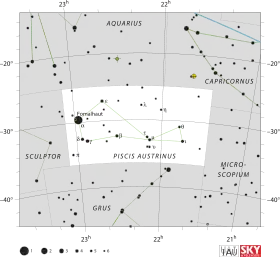Upsilon Piscis Austrini
Upsilon Piscis Austrini (υ Piscis Austrini) is a solitary,[9] orange-hued star in the southern constellation of Piscis Austrinus. It is faintly visible to the naked eye with an apparent visual magnitude of +4.98.[2] Based upon an annual parallax shift of 7.69 mas as seen from the Earth,[1] the star is located 420 light-years from the Sun.

| |
| Observation data Epoch J2000.0 Equinox J2000.0 (ICRS) | |
|---|---|
| Constellation | Piscis Austrinus |
| Right ascension | 22h 08m 25.93132s[1] |
| Declination | −34° 02′ 37.8248″[1] |
| Apparent magnitude (V) | +4.98[2] |
| Characteristics | |
| Spectral type | K4 III[3] |
| B−V color index | +1.50[2] |
| Astrometry | |
| Radial velocity (Rv) | +20.1[4] km/s |
| Proper motion (μ) | RA: +4.55[1] mas/yr Dec.: −49.02[1] mas/yr |
| Parallax (π) | 7.69 ± 0.22 mas[1] |
| Distance | 420 ± 10 ly (130 ± 4 pc) |
| Absolute magnitude (MV) | −0.47±0.062[5] |
| Details | |
| Temperature | 4,066[6] K |
| Rotational velocity (v sin i) | 1.0±1.0[7] km/s |
| Other designations | |
| Database references | |
| SIMBAD | data |
This is an evolved K-type giant star with a stellar classification of K4 III.[3] It is catalogued as a member of the Wolf 630 moving group.[10] Upsilon Piscis Austrini is moving through the galaxy at a speed of 36.4 km/s relative to the Sun. Its projected galactic orbit carries it between 17,700 and 25,400 light-years from the center of the galaxy.[11]
References
- van Leeuwen, F. (2007), "Validation of the new Hipparcos reduction", Astronomy and Astrophysics, 474 (2): 653–664, arXiv:0708.1752, Bibcode:2007A&A...474..653V, doi:10.1051/0004-6361:20078357, S2CID 18759600.
- Corben, P. M.; Stoy, R. H. (1968), "Photoelectric Magnitudes and Colours for Bright Southern Stars", Monthly Notes of the Astronomical Society of Southern Africa, 27: 11, Bibcode:1968MNSSA..27...11C.
- Houk, Nancy (1979), Michigan catalogue of two-dimensional spectral types for the HD stars, vol. 3, Ann Arbor, Michigan: Department of Astronomy, University of Michigan, Bibcode:1982mcts.book.....H.
- Wilson, R. E. (1953), "General Catalogue of Stellar Radial Velocities", Carnegie Institute Washington D.C. Publication, Carnegie Institute of Washington, D.C., Bibcode:1953GCRV..C......0W.
- Park, Sunkyung; et al. (2013), "Wilson-Bappu Effect: Extended to Surface Gravity", The Astronomical Journal, 146 (4): 73, arXiv:1307.0592, Bibcode:2013AJ....146...73P, doi:10.1088/0004-6256/146/4/73, S2CID 119187733.
- Soubiran, C.; et al. (June 2010), "The PASTEL catalogue of stellar parameters", Astronomy and Astrophysics, 515: A111, arXiv:1004.1069, Bibcode:2010A&A...515A.111S, doi:10.1051/0004-6361/201014247, S2CID 118362423.
- Zamanov, R. K.; et al. (October 2008), "Rotational velocities of the giants in symbiotic stars - III. Evidence of fast rotation in S-type symbiotics", Monthly Notices of the Royal Astronomical Society, 390 (1): 377–382, arXiv:0807.3817, Bibcode:2008MNRAS.390..377Z, doi:10.1111/j.1365-2966.2008.13751.x, S2CID 118697261.
- "ups PsA -- Star", SIMBAD Astronomical Database, Centre de Données astronomiques de Strasbourg, retrieved 2017-05-17.
- Eggleton, P. P.; Tokovinin, A. A. (September 2008), "A catalogue of multiplicity among bright stellar systems", Monthly Notices of the Royal Astronomical Society, 389 (2): 869–879, arXiv:0806.2878, Bibcode:2008MNRAS.389..869E, doi:10.1111/j.1365-2966.2008.13596.x, S2CID 14878976.
- McDonald, A. R. E.; Hearnshaw, J. B. (August 1983), "The Wolf 630 moving group of stars", Monthly Notices of the Royal Astronomical Society, 204 (3): 841–852, Bibcode:1983MNRAS.204..841M, doi:10.1093/mnras/204.3.841.
- Upsilon Piscis Austrini (HIP 109289)
This article is issued from Wikipedia. The text is licensed under Creative Commons - Attribution - Sharealike. Additional terms may apply for the media files.